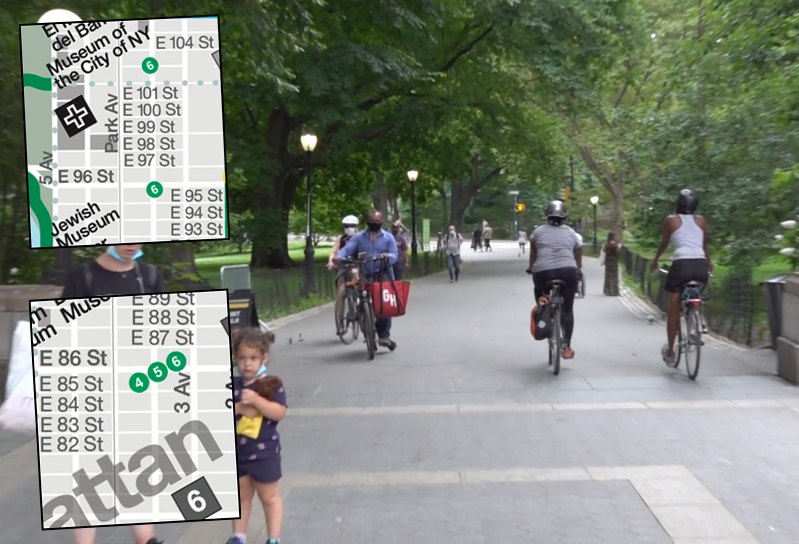Citi Bike Data Show How Many Cyclists Cross Central Park, Highlighting Need for Safe Routes
12:01 AM EDT on April 17, 2023

Cyclists in Central Park have to use pedestrian paths because (inset) there are no crosstown routes. File photo: Clarence Eckerson Jr.
As the stewards of Central Park are studying how to make the green space safer for pedestrians and cyclists following a spate of crashes, new data shows that a whopping 38,852 people — more than 1,000 a day — traversed the park on Citi Bikes last August.
Zhi Keng He of BetaNYC analyzed public Citi Bike data, looking at where people took out a big blue bike and then where they docked it across the park. And the numbers show that lots of Citi Bike riders — not to mention all the people on their own bikes — are crossing the park, despite having no safe or dedicated option for crossing the park.
There’s only one sanctioned shared bike and pedestrian path above 95th Street, but the dangerous Central Park transverses — which are dominated by vehicles at 96th, 86th, 79th and 65th streets — are often preferred by riders because the designated bike paths through the green space are hilly, indirect or marked with signs demanding that bikers “dismount and walk.”

It's unclear exactly what route was used by each cyclist in He's analysis — the park’s transverses or its shared pathways — but one can assume that they cut through the park based on the pickup and drop points.
The biggest ridership is in the southern third of the park: In a single month, 20,206 Citi Bikes were undocked between 60th and 79th streets and were later docked on the other side of the park.
Another 14,028 crosstown rides were begun between 79th and 96th streets on either side of the park. And another 4,568 people took out a bike between 96th and 110th streets and ended up on the other side of the park, according to the numbers crunched by He.
In each direction, the biggest share of riders, 7,896, took out a bike on the east side of the park between 60th and 79th streets and docked it within the same boundaries on the west side. And heading eastbound, the highest number of riders, 4,496, similarly crossed the park between 60th and 79th streets.
The smallest number of riders, 486, commuted eastbound between 96th and 110th streets; and in the other direction, 874 crossed the park and docked between the same streets, according to the data.
Advocates have long been calling for safe routes through Central Park — a request that only intensified during the pandemic as more New Yorkers, including health care workers, turned to cycling, and following the death of Daniel Cammerman in 2019 — a beloved pediatrician, husband, and father of two who was killed by the driver of a school bus on the 96th Street transverse.
And the stats will likely renew calls for better infrastructure throughout the greensward, which has become such a chaotic mix of cyclists, pedestrians, horse and carriages, and pedicabs carrying tourists that even the former Parks Department Commissioner, Adrian Benepe, said he no longer bikes in it.
Carl Mahaney, the director of StreetopiaUWS, sees an opportunity.
“With purpose and creativity, we believe there’s a way to have frequent, safe, legal routes through the park for people on bikes that get them where they need to go without creating unsafe or uncomfortable conditions for pedestrians and other park users,” he said.
But currently, "thousands of people crossing the park by bike everyday are put in a position where they either break the rules by riding on the footpaths and endure constant scolding from other park users, or risk their lives by riding on the transverse roads," Mahaney added. "We don’t have data for how many people look at this situation and choose not to ride at all, instead choosing to take a car across town when they would rather be riding a bike through a park."
The numbers also highlight where in the park the conservancy should add more bike infrastructure, said Mahaney, pointing to the fact that the majority of rides, 13,010, docked between 60th and 79th streets on the west side of the park; and docking on the east side, Citi Bike logged 7,698 rides within the same zone.
But despite the large number of riders that rely on the green space to get across town, safety issues have been plaguing the park for years.
Last year, a 34-year-old woman was hit and critically injured by a 50-year-old cyclist while she was jogging south on West Drive near W. 66th Street just days before the New York City Marathon, when the construction of its pavilion encroaches on the loop’s lanes.
And in 2019, 43-year-old Charles Cheeseboro, who was riding an e-bike, died from his injuries after colliding with a pedestrian on 74th Street on East Drive and hitting his head on the ground. Streetsblog reported at the time that Cheeseboro had wiped out at an especially dangerous crossing — a traffic-signalized intersection at the bottom of a relatively steep incline, and where traffic from three different sides converge.
The dangers had become so frequent and apparent that even former Mayor Bill de Blasio admitted that plans to improve safety in the park for pedestrians and cyclists was long overdue.
“We need to do more immediately,” de Blasio said on WNYC’s Brian Lehrer show in August 2021.
And the plans have been a long time coming. The Central Park Conservancy told Streetsblog late last year that it is reviving a study that was first commissioned in 2018, when the park’s roadways were made largely car free by former Mayor Bill de Blasio. The conservancy tapped Sam Schwartz Engineering to study the issues and figure out how to make the green space more conducive for all types of users. A spokesperson for the conservancy confirmed that the study includes both the loop and the transverses.
“The issues have been the issues for some time. A lot of these discussions began in 2018 and 2019 and then got put on the shelf because of the pandemic. ... We know that bikers have trouble getting east and west,” conservancy Vice President David Saltonstall told Manhattan Community Board 8 last week. “Crossings can be extremely challenging, especially for seniors and children. Enforcement is a constant challenge. There are probably more pedicabs and horse carriages in the park than there were five years ago. We’re seeing more people at more times of day.”
A spokesperson for the conservancy urged the public to take its survey about how people use the park in order to inform the study and changes.
“We know that millions of people use Central Park’s Drives in a variety of ways, including to cycle within the Park whether recreationally, to commute, to make deliveries, or for work. That’s why we want to continue to hear from the public about their experience with the Drives so we can offer suggested solutions to improve safety and mobility for everyone," the spokesperson said. "Over the coming months and into the summer, we’ll continue to engage the public through upcoming Community Board and public meetings.”
The Citi Bike data comes as advocates and community members are also calling on the Department of Transportation to install crosstown bike lanes on the Upper West and East sides following the death of 28-year-old Carling Mott, who was killed last year on the Upper East Side after the city failed to build a bike lane, capitulating to pressure from powerful East Siders, including Rep. Carolyn Maloney and a sister to then-Gov. Andrew Cuomo.
Julianne Cuba joined Streetsblog in February, 2019, after three years covering local news and politics at The Brooklyn Paper. There, she also covered the notoriously reckless private carting industry and hit-and-runs. A 2015 graduate of Stony Brook University’s School of Journalism Master’s Program, she lives in Brooklyn. Julianne is on Twitter at @julcuba. Email Julianne at julianne@streetsblog.org
Stay in touch
Sign up for our free newsletter
More from Streetsblog New York City
Justice Dept., Citing Streetsblog Reporting, Threatens to Sue NYPD Over Cops’ Sidewalk Parking
The city is now facing a major civil rights suit from the Biden Administration if it doesn't eliminate illegal parking by cops and other city workers.
What to Say When Someone Claims ‘No One Bikes or Walks in Bad Weather’
Yes, sustainable modes are more vulnerable to bad weather. But that's why we should invest more in them — not less.
NYC Transit’s New Operations Planning Chief Wants To Fight ‘Ghost Buses’
One-time transit advocate and current MTA Paratransit VP Chris Pangilinan will oversee bus and subway operations for the whole city.
Friday’s Headlines: Gimme Bus Shelter Edition
The days of the Landmarks Preservation Commission reviewing every proposed bus shelter in landmarked districts may be no more. Plus more news.
Deal Reached: Hochul Says ‘Sammy’s Law’ Will Pass
The bill, though imperfect, has been four years in the making.




